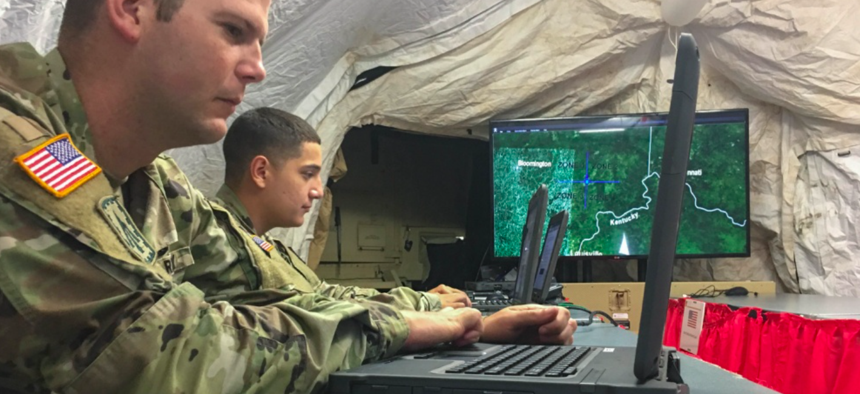
Soldiers from the 94th Army Air and Missile Defense Command, track an unmanned aerial systems (UAS) threat during a scenario as part of Black Dart 18 on Muscatatuck Urban Training Center, Indiana, Sept. 17. U.S. ARMY
US Army Aims to Put Cloud Data In Troops’ Hands
The Army Research Lab is funding tech that could put the computing power of the cloud in the hands of individual soldiers—and ultimately bring more artificial intelligence to the battlefield.
Telecom networks are to smart devices what roads are to Ferraris—without the first, the second is sleek, expensive and essentially useless.
Today, soldiers may find themselves equipped with an ever-expanding arsenal of digital tools, but they’re often deployed in environments where connectivity is shoddy at best. As the Defense Department looks to bring more advanced analytic tools to the field, it needs to bring computing and networking power closer to the battle.
On Jan. 16, the Army Research Lab awarded a $1 million contract to the Technica Corporation to build a system that brings together data from the myriad devices on the modern battlefield and allows soldiers to crunch that information off the grid. The so-called “fog computing” platform could ultimately allow troops to build machine-learning tools on the fly and apply them in areas without network access.
The Pentagon is investing heavily in cloud technology to support its operations around the globe, but sometimes cloud isn’t ideal for battlefield operations, Brendon Unland, Technica’s senior technology architect, told Nextgov.
In situations where networks are unavailable or units need to go dark, cloud-powered analytics tools become unavailable, he said. And even when soldiers can connect to the cloud, the network often doesn’t have the bandwidth to handle the flood of information from vehicles, sensors and other internet-connected devices.
“When you have this exponential increase in [internet of things] devices ... there's absolutely no way that all that data is going to be able to go from the device to the cloud,” Unland said. “[In] the battlefield of 2030 or 2040, you're just going to have tons and tons of sensors. Making sense of all that data with current architectures ... will be impossible.”
The Technica platform, however, would act as a middle tier between local devices and the cloud, giving soldiers ready access to computing power and storage space, he said. Powered by nodes in vehicles and soldiers backpacks, the system, called SmartFog, would let soldiers analyze incoming data streams in real-time, he said.
SmartFog would be outfitted with a handful of artificial intelligence tools to inform decisions when the cloud is unavailable, said Doug Sickler, Technica’s vice president of business development.
The cloud has enabled agencies and industry to build extremely powerful artificial intelligence tools, but in environments with limited connectivity, it can take those systems a long time to crunch data and give feedback, Sickler told Nextgov. Though AI tools hosted by SmartFog wouldn’t be as powerful, they could provide soldiers with quick answers about their immediate surroundings, he said.
Under the current contract, Technica is building a handful of versatile AI algorithms to integrate within the fog platform. The algorithms could be trained on locally gathered data to detect vehicle maintenance problems, network attacks or other anomalies, Unland said.
Though AI tools would be trained within an individual unit’s fog network, he said they could later absorb data from other units to refine their algorithms. This process, called federated learning, could be accomplished entirely without a connection to the cloud.
At the end of their three-year contract, they said, the team aims to begin integrating other machine learning tools developed by the Pentagon into SmartFog.
“The area that we're interested in ... is how can we bring AI to the tactical edge,” said Unland. “We want to try to put deep learning and AI into the hands of the soldier.”





